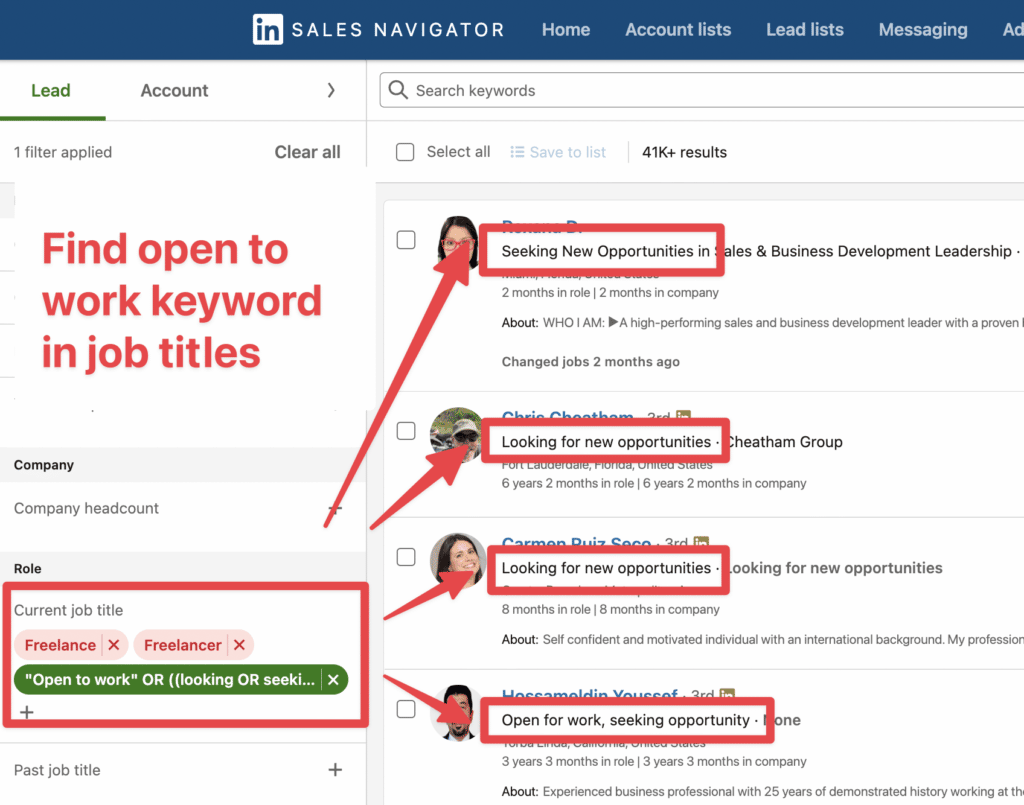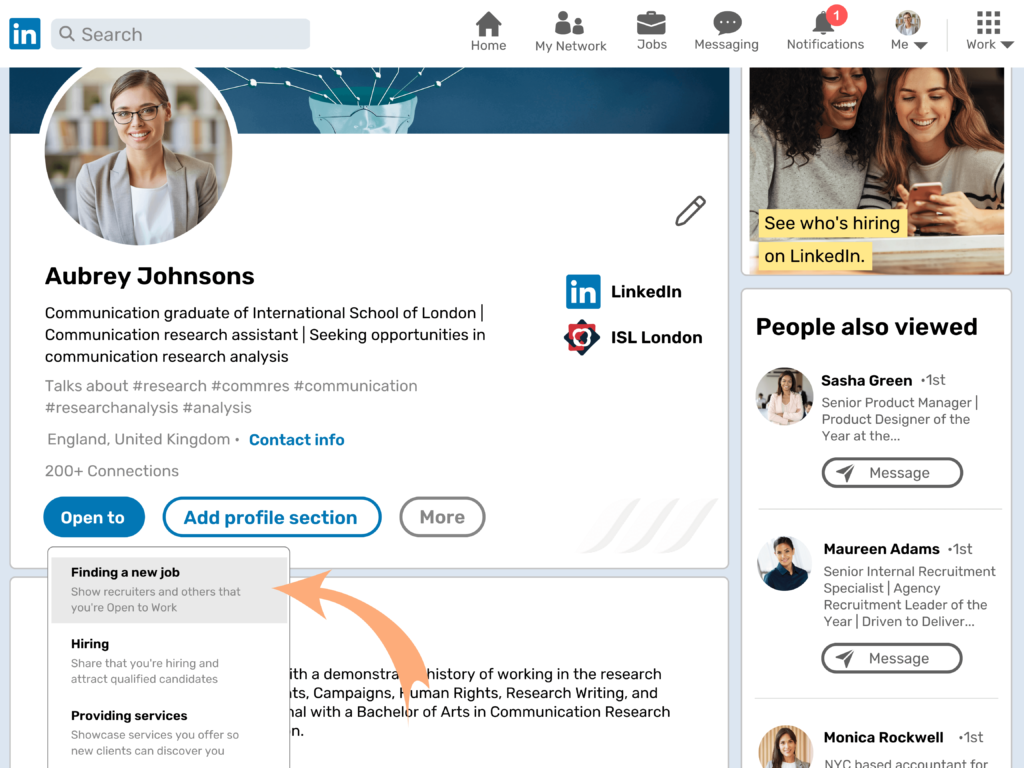Introduction
Welcome to the comprehensive guide on leveraging
LinkedIn's "Open to Work" feature. In today's competitive job market, it's crucial to utilize every tool at your disposal to stand out and connect with potential employers or recruiters.
LinkedIn's Open to Work feature offers a strategic way to signal your availability for new opportunities, increasing your visibility to relevant parties within your network and beyond. In this guide, we'll explore how you can effectively utilize this feature to enhance your job search and career prospects.
Understanding Open to Work Feature on LinkedIn
 LinkedIn
LinkedIn's
Open to Work feature is a powerful tool designed to assist job seekers in their quest for new opportunities. By activating this feature on your profile, you signal to recruiters and hiring managers that you are actively seeking employment. Let's delve deeper into the key aspects of this feature:
Visibility
When you enable the Open to Work feature,
LinkedIn adds a distinctive green frame around your profile photo, indicating your availability. This visual cue helps your profile stand out in search results and notifications, making it easier for recruiters to identify potential candidates.
Privacy Settings
LinkedIn understands the importance of privacy, especially when it comes to job searching. Therefore, they offer several options to control the visibility of your job-seeking status:
- Public Visibility: You can choose to display the "Open to Work" badge to everyone, including those outside your network.
- Network Visibility: Alternatively, you can limit the visibility to only your LinkedIn connections, providing a more discreet approach.
Job Preferences
Along with indicating your availability, the Open to Work feature allows you to specify your job preferences, such as:
- Job Titles: Specify the job titles you're interested in, ensuring that recruiters can match you with relevant opportunities.
- Locations: Indicate your preferred locations for work, whether it's specific cities, regions, or remote opportunities.
- Job Types: Choose between full-time, part-time, contract, or freelance work to align with your preferences and career goals.
Notification to Recruiters
Once you activate the Open to Work feature and set your job preferences,
LinkedIn notifies recruiters who use
LinkedIn's Recruiter platform about your availability. This proactive approach increases the likelihood of receiving relevant job opportunities directly in your inbox.
Featured Section
LinkedIn also offers a dedicated section on your profile to highlight your job-seeking status and preferences. This section allows you to provide additional context, such as a brief summary of your career goals or the types of roles you're passionate about.By understanding and effectively utilizing the Open to Work feature on LinkedIn, you can significantly enhance your job search efforts and increase your chances of landing your dream role.
Optimizing Your Profile for Open to Work
Maximizing the effectiveness of LinkedIn's Open to Work feature requires strategic optimization of your profile. Here are some essential steps to ensure your profile is primed for success:
1. Complete Your Profile
Ensure that your LinkedIn profile is complete and up-to-date. This includes:
- Profile Photo: Use a professional-looking photo that conveys your professionalism and approachability.
- Headline: Craft a compelling headline that accurately reflects your expertise and career aspirations.
- Summary: Write a concise yet impactful summary that highlights your skills, experiences, and career objectives.
- Experience: Provide detailed descriptions of your work experience, emphasizing achievements and results.
- Skills: List relevant skills and endorsements to showcase your expertise.
2. Customize Your Open to Work Settings
Take advantage of LinkedIn's customization options to tailor your Open to Work settings:
| Setting | Description |
|---|
| Visibility | Choose who can see that you're open to work, whether it's everyone or only your connections. |
| Job Preferences | Specify your job titles, locations, and job types to receive relevant job opportunities. |
3. Craft a Compelling Headline and Summary
Your headline and summary are among the first things recruiters see when they visit your profile. Make them count:
- Headline: Use keywords related to your desired job roles to increase your profile's visibility in search results.
- Summary: Tailor your summary to showcase your strengths, experiences, and career objectives, making it easy for recruiters to understand your value proposition.
4. Highlight Achievements and Skills
Make sure to highlight your achievements and skills throughout your profile:
- Experience Section: Use bullet points to succinctly describe your accomplishments in each role.
- Skills Section: Include a diverse range of skills relevant to your target job roles.
By optimizing your LinkedIn profile for the Open to Work feature, you increase your chances of attracting relevant job opportunities and connecting with recruiters who can help advance your career.
Creating an Effective Open to Work Post
An Open to Work post on LinkedIn can significantly amplify your job search efforts and attract relevant opportunities. Follow these steps to craft a compelling and effective post:
1. Start with a Clear Introduction
Begin your post by clearly stating that you are open to new job opportunities. Use a concise and attention-grabbing introduction to capture the reader's interest.
2. Highlight Your Skills and Expertise
Emphasize your key skills, experiences, and achievements in the body of your post. Use
bold text to highlight important keywords and make your content more scannable.
3. Specify Your Job Preferences
Be specific about the types of roles you are seeking. Mention your preferred job titles, industries, and locations to help recruiters better understand your preferences.
4. Share Relevant Accomplishments
Share success stories or notable achievements from your previous roles. Use bullet points or numbered lists to organize your accomplishments and make them easy to digest.
5. Call to Action
End your post with a clear call to action, inviting recruiters and hiring managers to reach out to you if they have suitable opportunities. Encourage engagement by asking readers to like, comment, or share your post.
6. Utilize Visuals
Enhance your post with visuals such as images, videos, or infographics to make it more engaging and visually appealing. Visual content can help grab the reader's attention and convey information more effectively.
7. Monitor and Respond
Once you've published your Open to Work post, monitor the engagement and respond promptly to any inquiries or messages you receive. Engaging with your audience demonstrates your professionalism and proactive approach.By following these steps, you can create a compelling Open to Work post that increases your visibility, attracts relevant opportunities, and helps you land your next job.
Engaging with Your Network
Engaging with your network on LinkedIn is essential for maximizing the effectiveness of your Open to Work status. Here are some strategies to effectively engage with your connections:
1. Regular Updates
Stay active on LinkedIn by posting regular updates about your job search journey, achievements, and industry insights. Sharing valuable content keeps you top of mind with your network and increases the likelihood of relevant opportunities coming your way.
2. Interact with Posts
Engage with posts from your connections by liking, commenting, and sharing. Offer meaningful insights or ask questions to initiate conversations and build relationships with peers, recruiters, and industry professionals.
3. Utilize LinkedIn Groups
Join relevant LinkedIn groups related to your industry or job function. Participate in group discussions, share your expertise, and connect with like-minded professionals. Engaging in group conversations expands your network and exposes you to new opportunities.
4. Personalized Messages
When reaching out to connections, personalize your messages to make them more meaningful and memorable. Mention common interests or mutual connections to establish rapport and foster genuine relationships.
5. Offer Help and Support
Be proactive in offering help and support to your network. Whether it's providing feedback on a colleague's project or offering assistance with a job search, demonstrating your willingness to contribute strengthens your professional relationships.
6. Attend Networking Events
Participate in virtual or in-person networking events to expand your network and meet new contacts. Engage in conversations, exchange business cards, and follow up with connections afterward to maintain the relationship.
7. Express Gratitude
Express gratitude to connections who offer support, guidance, or job leads. Sending personalized thank-you messages shows appreciation and reinforces the relationship.By actively engaging with your network on LinkedIn, you not only increase your visibility but also build meaningful connections that can support you throughout your career journey.
FAQs
Here are some frequently asked questions about the Open to Work feature on LinkedIn:
What is the Open to Work feature?
The Open to Work feature on LinkedIn allows users to indicate their job-seeking status and preferences, making it easier for recruiters and hiring managers to identify potential candidates.
How do I activate the Open to Work feature?
To activate the Open to Work feature, navigate to your LinkedIn profile, click on the "Open to" button near your profile picture, and select "Finding a new job" from the dropdown menu. You can then customize your job preferences and visibility settings.
Who can see that I'm open to work?
Depending on your privacy settings, your Open to Work status can be visible to everyone on LinkedIn or only to your connections. LinkedIn offers options to control the visibility of your job-seeking status to ensure privacy.
Will my current employer be notified if I enable the Open to Work feature?
No, LinkedIn does not notify your current employer when you activate the Open to Work feature. Your job-seeking status is visible only to recruiters and hiring managers who use LinkedIn's recruiting tools.
How can I maximize the effectiveness of the Open to Work feature?
To maximize the effectiveness of the Open to Work feature, ensure that your LinkedIn profile is complete and optimized, specify your job preferences accurately, regularly update your status and engage with your network.
Can I specify the types of job opportunities I'm interested in?
Yes, you can specify your job preferences, including job titles, industries, locations, and job types, to receive relevant job opportunities that align with your career goals and aspirations.
Is there a limit to how long I can use the Open to Work feature?
No, there is no time limit for using the Open to Work feature on LinkedIn. You can activate or deactivate it at any time based on your job search status and preferences.
Conclusion
LinkedIn's Open to Work feature is a valuable tool for job seekers looking to enhance their visibility and connect with potential employers. By leveraging this feature effectively, you can increase your chances of finding new job opportunities and advancing your career.In this comprehensive guide, we've explored the various aspects of the Open to Work feature, including how to activate it, optimize your profile, create engaging posts, and interact with your network. By following the strategies outlined in this guide, you can make the most of LinkedIn's Open to Work feature and stand out in today's competitive job market.Remember to regularly update your profile, engage with your network, and stay proactive in your job search efforts. By maintaining a strong online presence and building meaningful connections, you can position yourself for success and achieve your career goals.Thank you for reading this guide. We hope you found it helpful and wish you the best of luck in your job search journey!
 LinkedIn's Open to Work feature is a powerful tool designed to assist job seekers in their quest for new opportunities. By activating this feature on your profile, you signal to recruiters and hiring managers that you are actively seeking employment. Let's delve deeper into the key aspects of this feature:
LinkedIn's Open to Work feature is a powerful tool designed to assist job seekers in their quest for new opportunities. By activating this feature on your profile, you signal to recruiters and hiring managers that you are actively seeking employment. Let's delve deeper into the key aspects of this feature:
 admin
admin








